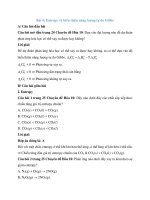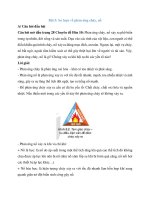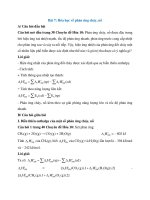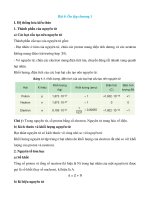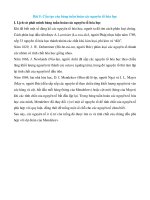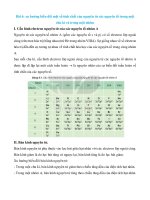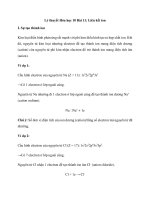The Choice of Coordination Number in d10 Complexes of Group 11 Metals
Bạn đang xem bản rút gọn của tài liệu. Xem và tải ngay bản đầy đủ của tài liệu tại đây (117.58 KB, 21 trang )
The Choice of Coordination Number in d10 Complexes of Group 11 Metals
M. Angels Carvajal, Juan J. Novoa and Santiago Alvarez
Supporting Information
Structural Database Survey
The structural data used for Figure 1 were obtained through a systematic search for
complexes of group 11 metals classified in the Cambridge Structural Database1 (CSD, version
5.23) as di-, tri- and tetracoordinate. Only those structures that could be unambiguously
identified as corresponding to oxidation state +1 were retained and structures presenting
disorder or with agreement factors R in excess of 10 % were ruled out. In the context of this
work, the coordination number of a metal atom in a given crystal structure is the one that has
been proposed by the authors of the crystallographic determination from a comparison of
metal-ligand bond distances with the sum of atomic radii, as reflected in the CSD. A
breakdown of structures found in the CSD by metal and coordination number is presented in
Table S1. In some cases (less than a 5% of the selected compounds) the assignment of
coordination number to the metal atom is not straightforward, and the corresponding structures
have been classified by us as “ambiguous”. For instance, we assign an ambiguous
coordination number two to those structures with bond angles of less than 140°. Among
"tricoordinate" complexes, we count as having an ambiguous coordination number those in
which the metal atom is at least 0.6 Å above (or below) the plane formed by the three donor
atoms. Finally, ambiguous tetracoordinate structures are considered to be those with one bond
angle smaller than 60° or with torsion angles between two L-M-L groups smaller than 45°. For
statistical purposes (as reflected in Figure 1), however, we have kept the coordination number
assigned by the CSD, given the small proportion of ambiguous cases.
All (ambiguous) "dicoordinate" molecules with bond angles smaller than 147° are seen to have
metal-ligand contacts at less than 2.8 Å (13 crystallographically independent molecules in 9
compounds), mostly to sulfur or oxygen atoms, but also in one case6 to carbon atoms of a
phenyl ring at 2.53, 2.91 and 2.96 Å, suggestive of a p-allylic coordination. In all the
ambiguous tricoordinate complexes the metal atom presents either one additional short contact
to a donor atom, indicating effective tetracoordination, or one too long "bond distance" that
should be considered nonbonding, indicating an effective coordination number of two.
Similarly, the ambiguous tetracoordinate complexes have either one long metal-ligand bond
distance and bond angles consistent with tricoordination, or two long bond distances and a
nearly linear arrangement of the other two ligands, indicative of effective dicoordination
S1
Table S1. Distribution of d10 complexes of group 11 metals with different coordination
numbers (CN) in the Cambridge Structural Database (version 5.23). Both the number of
independent crystallographic data sets (molecules) and of crystal structure determinations
(structures) are given. Criteria for number of fragments with ambiguous coordination number
are discussed in the computational section, but the corresponding structures are counted with
the coordination number assigned in the CSD.
M
CN
Cu
2
319
185
9
3
818
462
16
4
1632
1127
186
2
310
225
8
3
332
246
13
4
669
467
28
2
1252
877
0
3
83
64
0
4
172
142
1
Ag
Au
molecules
structures
ambiguous
S2
Table S2. Basis sets employed for the DFT calculations.
Polarizationa
Atom
Cu
Ag
Au
Cl
p
p
p
d
Diffuseb
0.052
s
0.00396
0.164
p
0.00240
d
0.03102
0.035
s
0.00347
0.105
p
0.00252
d
0.02108
0.034
s
0.00598
0.108
p
0.00279
d
0.01396
0.220
0.797
Br
d
0.162
0.548
I
d
0.105
0.334
N
d
0.412
1.986
P
d
0.153
0.537
a
Huzinaga, S.; Andzelm, J.; Klobukowski, M.; Radzi-Andzelm, E.; Sakai, Y.; Tatewaki, H. Gaussian
Basis Sets for Molecular Calculations; Elsevier: Amsterdam, 1984
b
Cu: Liu, X.-Y.; Mota, F.; Alemany, P.; Novoa, J. J.; Alvarez, S. Chem. Commun. 1998, 1149. Ag and
Au: dividing by 10 the smallest exponent of the LanL2DZ basis set.
S3
Table S3. Interaction and formation energies (Eint and Ef) calculated for the family of reactions
[CuL1L2] + L3 with and without (in parentheses) counterpoise correction for the basis set superposition
error.
L1
L2
NH3
NH3
Cl-
-126.3 (-142.1)
-109.5 (-125.3)
NH3
NH3
Br-
-121.0 (-131.6)
-104.2 (-114.8)
NH3
NH3
I-
-116.0 (-122.4)
-99.2 (-105.5)
NH3
NH3
NH3
-30.0 (-32.3)
-13.7 (-16.0)
PH3
PH3
PH3
-30.1 (-31.7)
-17.9 (-19.4)
NH3
Cl-
NH3
-15.6 (-18.5)
-0.2 (-3.1)
NH3
Br-
NH3
-16.1 (-18.7)
-2.0 (-4.7)
NH3
I-
NH3
-16.3 (-18.8)
-3.7 (-6.2)
Cl-
Cl-
Cl-
47.1 (33.2)
71.2 (57.4)
Br-
Br-
Br-
43.9 (33.3)
63.6 (53.0)
I-
I-
40.6 (34.2)
58.2 (51.8)
Cl-
Cl-
NH3
-5.0 (-8.3)
17.6 (14.3)
Br-
Br-
NH3
-6.8 (-9.7)
10.3 (7.4)
I-
NH3
-8.4 (-11.0)
7.0 (4.4)
NH3
Cl-
Cl-
-35.2 (-50.9)
-18.3 (-34.0)
NH3
Br-
Br-
-33.2 (-43.9)
-17.8 (-28.5)
NH3
I-
I-
-31.6 (-38.0)
-17.7 (-24.1)
I-
I-
L3
Eint
Ef
S4
Table S4. Optimized bond distances (Å) for dicoordinate d10 [MAB] complexes and ranges of
experimental values found in the CSD.
M-A
M.
A
B
calcd.
exp.
M-B
calcd.
exp.
A-M-B
exp.
N, Z
Cu
Cl
Cl
2.157
2.00 - 2.14
153-180
57, 71
Cu
Br
Br
2.303
2.19 - 2.29
154-180
18, 19
Cu
I
I
2.468
2.38 - 2.39
180
2, 2
Cu
NH3 NH3
1.942
1.80 - 2.11
152-180
92, 141
Cu
2.272
2.19 - 2.26
166-180
7, 9
Cu
PH3 PH3
NH3 Cl
1.959
1.80 - 1.94
2.098
2.08 - 2.16
159-180
9, 12
Cu
NH3 Br
1.970
1.93 - 1.94
2.238
2.20 - 2.22
174
1, 2
Cu
NH3 I
1.983
Cu
PH3 Cl
2.200
2.177
2.108
2.118
173
1, 1
Cu
PH3 Br
2.212
2.19 - 2.20
2.246
2.23 - 2.26
172-174
2, 2
Cu
PH3 I
2.225
2.188
2.409
2.418
171
1, 1
Ag
Cl
Cl
2.401
2.30 - 2.48
164-180
5, 5
Ag
Br
Br
2.537
2.45
179
1, 1
Ag
I
I
2.696
Ag
NH3 NH3
2.183
2.06 - 2.41
144-180
159, 229
Ag
2.474
2.36 - 2.46
145-180
26, 31
Ag
PH3 PH3
NH3 Cl
2.214
2.08 - 2.16
2.31
174-177
2, 2
Ag
NH3 Br
2.233
2.461
Ag
NH3 I
2.252
2.613
Ag
PH3 Cl
2.406
2.37 - 2.38
2.335
2.34 - 2.45
148-175
3, 3
Ag
PH3 Br
2.425
2.374
2.467
2.448
174
Ag
PH3 I
2.446
Au
Cl
Cl
2.347
2.09 - 2.30
176-180
21, 25
Ag
Br
Br
2.479
2.35 - 2.40
174-180
24, 24
Ag
I
I
2.635
2.24 - 2.75
176-180
20, 21
Ag
I
I
2.155
Au
NH3 NH3
2.081
1.80 - 2.15
173-180
31, 51
Au
2.358
2.26 - 2.35
157-180
112, 142
Au
PH3 PH3
NH3 Cl
2.117
1.98 - 2.10
2.278
2.24 - 2.27
177-179
6, 6
Au
NH3 Br
2.135
2.019
2.408
2.354
178
1, 1
Au
PH3 Cl
2.268
2.18 - 2.28
2.303
2.23 - 2.39
164-180
140, 209
Au
PH3 Br
2.282
2.16 - 2.29
2.434
2.38 - 2.44
168-179
19, 28
Au
PH3 I
2.299
2.399
2.327
2.621
2.560
180
2.587
(a) All calculated A-M-B bond angles are 180° within chemical accuracy. (b) N is the number of
crystalographically independent data sets and Z the number of crystal structure determinations
S5
Table S5. Calculated bond distances (Å) and anglesg for tricoordinate d10 [MAB2] complexes and
ranges of experimental values found in the Cambridge Structural Database (in parentheses).
M-A
M-B
A
B
calcd.
exp.
Cu
Cl
Cl
2.363
2.10 - 2.39
120
16, 21
Cu
Br
Br
2.502
2.22 - 2.52
120
24, 29
Cu
I
I
2.668
2.54 - 2.18
120
24, 30
Cu
NH3 NH3
2.077
1.91 - 2.09
120
81, 110
Cu
2.24 - 2.30
120
14, 23
Cu
PH3 PH3
2.332
a,
c
Cl
NH3
2.202
2.08 - 2.62
2.102
1.87 - 2.08
120
99-141
16, 20
Cu
Br
NH3
2.350
2.32 - 2.46
2.093
1.95 - 2.08
107
109-124
7, 10
Cu
Br
NH3a
2.340
Cu
I
NH3
2.505
105-128
6, 8
Cu
I
NH3a
2.498
Cu
Cl
PH3
2.192
112-120
10, 10
Cu
Cl
PH3a
2.190
Cu
Br
PH3
2.329
110-117
3, 4
Cu
Br
PH3 a
2.330
Cu
I
PH3
2.492
107-117
6, 8
Cu
I
2.490
Cu
NH3
PH3a
Cla, c
2.102
121-130
7, 9
Cu
NH3
Br d
2.338
Cu
NH3 Br a
2.123
1.93 - 2.06
2.411
2.37 - 2.42
120
116-125
6, 6
Cu
NH3 I
2.251
1.97 - 2.21
2.540
2.54 - 2.59
103
111-121
8, 12
Cu
NH3 Ia
2.119
Cu
PH3
Cu
PH3 Br
Br a
Cu
PH3
Cu
PH3 I
Ia
exp.
N, Z f
M
Cl a, c
calcd.
A-M-B
calcd.
exp.
2.103
2.49 - 2.68
2.100
120
1.98 - 2.02
2.105
2.20 - 2.26
2.297
120
2.23 - 2.27
2.300
2.34 - 2.40
2.303
2.308
2.23 - 2.27
2.202
116
120
2.24 - 2.29
2.310
1.86 - 1.99
116
120
2.300
2.51 - 2.62
115
116
120
2.27 - 2.43
2.37
120
92, 110
2.574
120
2.242
2.16 - 2.21
2.263
2.24 - 2.36
120
121-132
19, 24
2.360
2.16 - 2.48
2.377
2.18 - 2.58
118
109-132
15, 16
2.53 - 2.58 104, 116 120-127
11, 13
2.250
2.354
2.410
2.20 - 2.26
2.270
2.56
120
Cu
PH3
2.570
Ag
NH3 NH3
2.351
2.09- 2.50
120
39, 60
Ag
2.576
2.44 - 2.54
120
23, 38
Ag
PH3 PH3
Cl
Cl
2.638
2.45 - 2.81
120
5, 5
Ag
Br
Br
2.776
2.55 - 2.75
120
6, 6
Ag
I
I
2.930
2.75 - 2.80
120
7, 7
Ag
Cl
2.434
2.49 - 2.53
120
1, 2
Ag
Br
Ag
I
Ag
Cl
NH3a, c
NH3a, c
NH3a, c
PH3d, e
2.414
120
2.32 - 2.33
2.567
2.413
120
2.713
2.417
120
2.362
2.427, 3.124
84, 171
S6
Cl
PH3a
2.424
Ag
Br
2.507
Ag
Br
PH3d, e
PH3a
2.556
2.57 - 2.62
2.574
2.46 - 2.47
Ag
I
PH3
2.700
2.778
2.560
2.48
Ag
I
PH3a
2.709
2.583
120
Ag
NH3
Cl a, c
2.482
2.520
120
Ag
NH3 Bra, c
2.472
Ag
Id, e
Ag
NH3
Ag
NH3 Ia
2.49 - 2.71
2.567
2.42 - 2.50
2.456, 3.010
2.467
2.655
120
107-116
6, 6
115-118
2, 2
115
1, 1
102
1, 1
89, 164
2.500
120
08, 128
120
2.751
2.754
86, 108
2.466
2.807
120
Ag
PH3
Cl a, c
2.541
2.35 - 2.36
2.509
2.55 - 2.60
120
132-140
4, 4
Ag
PH3 Br a, b
2.559
2.37 - 2.41
2.647
2.61 - 2.65
120
125-131
2, 2
2.581
2.42 - 2.43
2.801
2.764
120
120
2, 2
I a, b
Ag
PH3
Au
NH3 NH3a, c 2.298
Au
PH3 PH3
Cl
Cl
Au
2.448
120
2.35 - 2.42
119
2.602
122
2.602
120
Au
Cl
Cla
Au
Br
Br
2.726
120
Au
I
I
2.863
120
Au
Cl
NH3a, c 2.406
2.375
120
Au
Br
2.527
2.380
120
Au
I
2.713
2.417
120
Au
Cl
Au
Br
Au
Br
NH3a, c
NH3a, c
PH3a, c
PH3d
PH3a
Au
I
Au
I
Au
2.421
2.44 - 2.96
2.601
2.414
2.30 - 2.33
2.40
120
27, 33
86-122
10, 12
96, 123
2.548
2.62 - 2.78
2.421
2.32
120
106-114
2, 2
PH3
2.752
2.75 - 3.34
2.394
2.32 - 2.34
110
94-114
4, 8
2.629
2.427
120
NH3
PH3a
Cla, c
2.549
2.474
120
Au
NH3
Bra, c
2.523
2.603
120
Au
NH3 Id, e
2.751
2.755
86, 108
2.506
2.748
120
Ia
Au
NH3
Au
PH3 Cla, b
2.331
2.503
120
Au
PH3
Bra, b
2.351
2.633
120
Au
PH3 Ia, b
2.369
2.780
120
a
) bond angles frozen at 120°; b) optimization leads to dissociation of one ligand; c) optimization leads to
dissociation of one ligand and formation of intermolecular hydrogen bonding; d) optimized structure is
asymmetric with intramolecular hydrogen bonding; e) optimization leads to a tricoordinate complex with a large
bond angle and one long metal-ligand distance.
f) N and Z are the number of crystal structure
determinations and the number of crystallographically independent molecules from which the
corresponding experimental values were taken, respectively. g) Calculated data correspond to
optimized structures except where otherwise specified.
S7
Table S6. Calculated bond distances (Å) and angles for tetracoordinate d10 [MA4], complexes and
ranges of experimental values found in the Cambridge Structural Database. N and Z are the number of
crystal structure determinations and the number of crystallographically independent molecules from
which the corresponding experimental values were taken, respectively. Calculated data correspond to
geometries with frozen tetrahedral bond angles except where otherwise specified.
M-A
M
A
Cu
Cl
2.596
2.35 - 2.42
9, 9
Cu
Br
2.764
2.31 - 2.57
8, 9
Cu
I a, b
2.948
2.65 - 2.72
15, 20
Cu
NH3
2.168
1.96 - 2.16
282, 395
Cu
PH3
2.368
2.24 - 2.58
38, 41
Ag
Cl a
2.715
2.61 - 2.64
3, 5
Ag
Br
2.906
2.71 - 2.74
3, 7
Ag
I
3.168
2.83 - 2.91
14, 26
Ag
NH3
2.451
2.23 - 2.49
62, 119
Ag
PH3
2.645
2.45 - 2.67
23, 31
Au
Cl a
2.863
Au
Br a
2.805
Au
I
2.897
Au
Ia
3.011
Au
NH3 a, c
2.425
Au
PH3
2.506
a
calcd.
exp.
N, Z
(139°) D2d
2.36 - 2.61
24, 28
) bond angles frozen at 109.47°; b) optimization leads to dissociation of one ligand; c) optimization leads to
dissociation of one ligand and formation of intermolecular hydrogen bonding; d) optimized structure is
asymmetric with intramolecular hydrogen bonding; e) optimization leads to a tricoordinate complex with a large
bond angle and one long metal-ligand distance; f) A-M-B bond angle in [MAB3] complexes, X-M-X bond angle
in [ML2X2] complexes; f) in [ML2X2] complexes.
S8
Table S7. Calculated bond distances (Å) and angles for tetracoordinate d10 [MAB3], complexes and
ranges of experimental values found in the Cambridge Structural Database. N and Z are the number of
crystal structure determinations and the number of crystallographically independent molecules from
which the corresponding experimental values were taken, respectively. Calculated data correspond to
geometries with frozen tetrahedral bond angles except where otherwise specified.
M-A
M-B
A-M-B
M
A
B
calcd.
exp.
calcd.
exp.
calcd.
exp.
N, Z
Cu
NH3
Cl a, b
2.167
1.99
2.458
2.46
112
1, 1
Cu
NH3
Br a, c
2.152
2.02 - 2.09
2.617
2.46 - 2.55
103-110
3, 4
Cu
NH3
I a, b
2.140
1.93 - 2.13
2.793
2.64 - 2.75
105-117
19, 36
Cu
PH3
Cl a
2.236
2.18 - 2.22
2.437
2.38 - 2.44
112-117
5, 6
Cu
PH3
Cl d, e
2.367
Cu
PH3
Br a
2.253
116-119
6, 6
Cu
PH3
Br d, e
2.352
Cu
PH3
I
2.360
2.24 - 2.26
2.763
2.67 - 2.70
100.0
109-112
4, 9
Cu
Cl
NH3
2.450
2.25 - 2.56
2.125
1.97 - 2.07
92
102-117
8, 9
Cu
Cl a
NH3
2.280
Cu
Br
NH3
2.140
2.43 - 2.58
97
104-110
4, 4
Cu
Br a
NH3
2.423
Cu
I
NH3
2.675
2.04 - 2.15
100
106-111
3, 3
Cu
I a
NH3
2.584
Cu
Cl
PH3
2.284
2.26 - 2.36
102
98-111
17, 20
Cu
Cl a
PH3
2.261
Cu
Br
PH3
2.433
2.23 - 2.37
106
103-109
5, 10
Cu
Br a
PH3
2.410
Cu
I
PH3
2.611
2.26 - 2.36
106
103-113
6, 9
Cu
Ia
PH3
2.578
2.352
Ag
NH3
Cl a, c
2.527
2.722
Ag
NH3
Br a, c
2.504
2.27
2.872
2.79
Ag
NH3
I a, c
2.489
2.29 - 2.40
3.032
2.85 - 2.92
106-113
3, 4
Ag
PH3
Cl a, b
2.565
2.36 - 2.41
2.693
2.62 - 2.71
116-134
6, 13
Ag
PH3
Br a, c
2.589
2.38 - 2.43
2.844
2.73 - 2.89
116-125
7, 12
Ag
PH3
I a, b
2.612
2.43 - 2.47
3.009
2.88 - 2.94
110-118
5, 9
Ag
Cl a
NH3
2.499
2.437
2.15 - 2.18
2.592
83, 108
2.52 - 2.56
2.568
92-105
2.194
1.98 - 2.03
2.543
2.191
2.68 - 2.71
2.156
2.188
2.28 - 2.90
2.337
2.351
2.44 - 2.53
2.337
2.350
2.61 - 2.69
2.336
1, 1
2.508
S9
Ag
Cl e
NH3
2.706
2.417
Ag
Br a, c NH3
2.636
2.505
Ag
I a, c
NH3
2.788
2.503
Ag
Cl
PH3
2.507
Ag
Cl a
PH3
2.481
Ag
Br
PH3
2.640
Ag
Br a
PH3
2.620
Ag
I
PH3
2.786
Ag
Ia
PH3
2.778
2.656
Au
NH3
Cl a, b
2.681
2.679
Au
NH3
Br a, b
2.625
2.815
Au
NH3
I a, b
2.583
2.963
Au
PH3
Cl a, c
2.330
2.710
Au
PH3
Br a, c
2.349
2.850
Au
PH3
I a, b
2.373
3.003
Au
Cl a, c NH3
2.464
2.531
Au
Br a, c NH3
2.527
2.531
Au
I a, c
NH3
2.726
2.534
Au
Cl
PH3
2.585
Au
Cl a
PH3
2.501
2.496
110
Au
Br
PH3
2.759
2.45
96
Au
Br a
PH3
2.636
2.498
110
Au
I
PH3
2.894
Au
Ia
PH3
2.788
a
2.47 - 2.59
2.625
83
2.49 - 2.57
103-123
5, 5
2.652
2.67 - 2.70
2.632
2.49 - 2.55
101
104-110
2, 4
2.48 - 2.63
103
104-126
4, 6
2.37 - 2.41
99
91-118
5, 5
98
1, 1
2.65
2.69 - 2.89
2.51 - 3.01
2.913
.643
2.448
2.46
2.502
2.334
98
110
) bond angles frozen at 109.47°; b) optimization leads to dissociation of one ligand; c) optimization leads to
dissociation of one ligand and formation of intermolecular hydrogen bonding; d) optimized structure is
asymmetric with intramolecular hydrogen bonding; e) optimization leads to a tricoordinate complex with a large
bond angle and one long metal-ligand distance; f) A-M-B bond angle in [MAB3] complexes, X-M-X bond angle
in [ML2X2] complexes; f) in [ML2X2] complexes.
S10
Table S8. Calculated bond distances (Å) and angles for tetracoordinate d10 [MA2B2], complexes and
ranges of experimental values found in the Cambridge Structural Database. N and Z are the number of
crystal structure determinations and the number of crystallographically independent molecules from
which the corresponding experimental values were taken, respectively. Calculated data correspond to
geometries with frozen tetrahedral bond angles except where otherwise specified.
M-A
M.
A
B
M-B
calcd.
exp.
calcd.
exp.
1.94 - 2.11
2.357
2.33 - 2.62
A-M-A
calcd. exp.
N, Z
Cu
Cl a, c NH3
2.204
Cu
Br a
NH3
2.183
Cu
Br d
NH3
2.221
1.97 - 2.12
2.54
2.41 - 2.62
138
Cu
I
NH3
2.221
2.04 - 2.07
2.666
Cu
Ia
NH3
2.177
Cu
Cl
PH3
2.359
Cu
Cl a
PH3
2.315
Cu
Br
PH3
2.351
2.24 - 2.26
Cu
I
PH3
2.346
2.24 - 2.29
Cu
Ia
PH3
2.327
Ag
Cla, c
NH3
2.546
Ag
Br a, c NH3
2.531
2.737
Ag
Ia
NH3
2.521
2.894
Ag
I d, e
NH3
2.712
2.830
Ag
2.641
2.43 - 2.52
2.567
2.60 - 2.76
110
74-103
12, 18
Ag
Cl a, b PH3
Br a, c PH3
2.647
2.42 - 2.50
2.712
2.74 - 2.84
110
91-101
5, 10
Ag
I a, b
PH3
2.656
2.46 - 2.55
2.872
2.88 - 2.90
110
80-89
2, 2
Au
Cl a, b NH3
2.686
2.544
Au
Br a, b NH3
2.645
2.676
Au
I a, b
NH3
2.600
2.826
Au
2.453
2.296
2.582
3.026
110
88
1, 1
Au
Cl a, c PH3
Br a, c PH3
2.463
2.299
2.718
3.117
110
92
1, 1
Au
I a, c
2.473
a
PH3
98-107
11, 12
95-109
17, 19
2.66 - 2.71
140 100-109
6, 6
2.32 - 2.55
130
87-104
17, 22
2.483
2.54 - 2.64
130
89-108
6, 11
2.664
2.66 - 2.77
129
97-109
11, 16
2.506
2.677
2.22 - 2.29
2.331
2.334
2.659
2.367
2.593
2.596
107
1, 1
156
2.871
) bond angles frozen at 109.47°; b) optimization leads to dissociation of one ligand; c) optimization leads to
dissociation of one ligand and formation of intermolecular hydrogen bonding; d) optimized structure is
asymmetric with intramolecular hydrogen bonding; e) optimization leads to a tricoordinate complex with a large
bond angle and one long metal-ligand distance; f) A-M-B bond angle in [MAB3] complexes, X-M-X bond angle
in [ML2X2] complexes; f) in [ML2X2] complexes.
S11
Table S9. Optimized geometries for [MCl(EMe3)2] complexes, compared to those of the
unsubstituted [MCl(EH3)2] analogues (M = Cu, Ag or Au; E = N or P).
M-L
M-X
Compd.
calcd.
exp.
calcd.
exp.
X-M-L
[CuCl(NMe3)2]
2.148
1.87 - 2.08
2.208
2.11 - 2.56
108, 129
[CuCl(NH3)2] a
2.102
[CuCl(PMe3)2]
2.281
[CuCl(PH3)2]
2.300
[AgCl(PMe3)2]
2.480
[AgCl(PH3)2] a
2.567
[AuCl(PMe3)2]
2.353
[AuCl(PH3)2] a
2.414
a)
2.202
2.23 - 2.27
2.252
120
2.20 - 2.26
2.188
2.42 - 2.50
2.579
116
2.49- 2.71
2.424
2.30 - 2.33
2.809
2.421
116, 104
96
120
2.44 - 2.96
89
120
bond angles frozen at 120°
S12
Table S10. Formation energies of tricoordinate complexes calculated in the gas phase and considering
a dielectric environment (CPCM approach) with bond angles frozen at 120°. Values given in
parentheses correspond to optimized geometries (Table 2).
X
Ef (gas phase)
Ef (water)
Ef (CH2Cl2)
[Cu(NH3)2]+ + NH3
-16.0
-5.4
-8.7
[Cu(PH3)2]+ + PH3
-19.4
-12.6
-16.2
Cl
-3.1
-3.1
-2.6
Br
-4.7
(-5.9)
-4.4
(-2.9)
-4.2
(-3.3)
I
-6.2
(-7.3)
-5.6
(-4.8)
-5.5
(-5.0)
Cl
-6.9
(-7.4)
-5.9
(-5.5)
-7.2
(-7.3)
Br
-7.5
(-8.2)
-6.5
(-6.2)
-7.9
(-8.0)
I
-8.3
(-8.3)
-7.0
(-7.0)
-8.4
(-8.7)
[CuX(NH3)] + NH3
[CuX(PH3)] + PH3
[Cu(NH3)2]+ + X-
[CuX(NH3)] + X-
[CuX2]- + NH3
[CuX2]- + X-
[Cu(PH3)2]+ + X-
[CuX(PH3)] + X-
Cl
-125.3
-4.9
-26.9
Br
-114.8
(-116.7)
0.63
(2.2)
-19.9
(-19.0)
I
-105.5
(-106.7)
2.3
(3.1)
-16.8
(-16.3)
Cl
-34.0
-5.5
-11.9
Br
-28.5
-1.3
-7.5
I
-24.1
(-28.6)
0.5
(1.8)
-4.9
(-5.8)
Cl
14.3
-2.1
3.6
Br
7.4
-4.0
0.9
I
4.4
(-0.1)
-4.8
(-3.2)
0.1
(-0.8)
Cl
57.4
-2.4
2.4
Br
53.0
-0.3
4.8
I
51.8
2.5
8.2
Cl
-142.2
(-142.7)
-23.6
(-23.3)
-47.9
(-48.0)
Br
-130.7
(-131.3)
-17.0
(-16.8)
-39.7
(-39.8)
I
-120.3
(-120.3)
-14.4
(-14.4)
-35.7
(-35.9)
Cl
-44.4
-12.9
-20.9
Br
-37.2
(-39.1)
-7.9
(-6.8)
-15.4
(-15.4)
I
-31.2
(-33.0)
-5.9
(-5.9)
-12.2
(-12.8)
S13
[CuX2]- + PH3
Cl
7.3
-0.7
0.9
Br
2.3
(0.4)
-1.6
(-0.5)
-0.6
(-0.6)
I
1.3
(-0.6)
-1.4
(-1.5)
-0.6
(-1.2)
S14
Table S11. Calculated bending and stretching energies (kcal/mol) for the [MAB] complexes at
fixed bond angles of 120° in a tricoordinate complex. Of the two values of Estr given, the first
one corresponds to bond length relaxation after bending, the second one to the same degree of
bond stretching prior to bending.
A
B
Cu
Ag
Au
Ebend
Estr
Ebend
Estr
Ebend
Estr
NH3
NH3
17.5
-0.7 / -1.2
13.2
-0.7 / -1.7
34.1
-0.3 / -1.6
PH3
PH3
11.0
+0.6 / -1.2
10.7
+0.1 / -1.7
22.3
0.6 / -0.4
Cl
NH3
15.7
+1.2 / -0.4
12.5
+0.6 / -1.2
28.0
+1.3 / -2.3
Br
NH3
14.3
+1.1 / -0.4
11.5
+0.6 / -0.9
25.0
+1.0 / -2.1
I
NH3
12.8
+0.6 / -0.3
10.5
+0.6 / -0.7
22.8
+0.3 / -2.2
Cl
PH3
12.9
+1.6 / +0.1
12.4
+0.6 / -0.9
24.9
+0.8 / -0.5
Br
PH3
12.0
+1.4 / 0.0
11.5
+0.6 / -0.7
22.7
+0.8 / -0.4
I
PH3
10.8
+1.4 / +0.1
10.6
+0.7 / -0.6
20.8
+0.8 / -0.3
Cl
Cl
22.3
+1.9 / -0.1
16.5
+2.8 / -0.5
25.6
+3.5 / -0.8
Br
Br
16.8
+2.9 / 0.0
15.0
+2.6 / -0.4
22.4
+3.0 / -0.6
I
I
15.0
+2.6 / +0.1
13.8
2.4 / -0.3
19.9
+2.4 / -0.5
S15
Table S12. Calculated pyramidalization energy for [MABC] trigonal complexes to tetrahedral
angles (Epyr) and stretching energies for the relaxation of bond distances of the [MABC]
fragment in tetrahedral complexes (Estr, first value corresponds to the maximum value in
compounds resulting from the addtion of a neutral ligand, the value in parenthesis for
compounds resulting from addition of a halide). All values in kcal/mol.
A
B
C
Cu
Ag
Epyr
Au
Epyr
|Estr|
|Estr|
Epyr
|Estr|
NH3 NH3 NH3
8.7
0.2
(0.8)
5.6
0.2
(1.3)
11.7
0.0
(3.6)
PH3 PH3 PH3
8.7
0.2
(0.6)
6.9
0.2
(0.4)
14.8
0.8
(0.4)
Cl
NH3 NH3
7.5
0.3
(1.8)
4.4
0.2
(2.0)
8.7
0.1
(3.8)
Br
NH3 NH3
7.2
0.3
(1.3)
4.4
0.2
(1.8)
8.5
0.1
(3.0)
I
NH3 NH3
7.0
0.2
(1.2)
4.5
0.2
(1.6)
8.3
0.0
(2.0)
Cl
PH3 PH3
7.9
0.1
(1.6)
5.8
0.2
(1.0)
12.7
0.2
(1.2)
Br
PH3 PH3
7.5
0.1
(1.5)
5.6
0.1
(1.2)
12.3
0.2
(1.1)
I
PH3 PH3
7.3
0.1
(1.3)
5.5
0.1
(1.1)
11.9
0.2
(1.0)
Cl
Cl
NH3
8.5
0.4
(3.0)
5.8
0.4
(3.3)
8.2
0.2
(3.9)
Br
Br
NH3
8.2
0.0
(2.9)
5.9
0.3
(3.0)
8.3
0.1
(3.4)
I
I
NH3
7.9
0.0
(2.7)
6.0
0.1
(2.6)
8.4
0.3
(2.8)
Cl
Cl
PH3
9.5
0.2
(2.9)
6.8
0.1
(2.7)
11.6
0.3
(2.8)
Br
Br
PH3
9.0
0.2
(2.6)
6.7
0.0
(2.5)
11.1
0.2
(2.5)
I
I
PH3
8.5
0.1
(2.4)
6.5
0.0
(2.4)
10.9
0.1
(2.1)
Cl
Cl
Cl
12.2
0.6
(5.2)
10.0
0.3
(0.5)
10.7
0.8
(5.6)
Br
Br
Br
12.0
0.6
(5.3)
9.8
0.5
(1.1)
10.7
0.8
(0.1)
I
I
I
11.5
0.7
(5.0)
9.6
0.4
(3.1)
10.9
0.7
(0.9)
S16
Table S13. Optimized metal-ligand bond distances in homoleptic [MLn]+ complexes as a function of
the coordination number (Å).
L
M
ML2
ML3
NH3
Cu
1.942
2.077
2.168
Ag
2.183
2.351
2.451
Au
2.081
2.298
2.425
Cu
2.272
2.332
2.368
Ag
2.474
2.576
2.645
Au
2.358
2.448
2.506
Cu
2.157
2.368
2.596
Ag
2.401
2.638
2.715
Au
2.347
2.602
2.863
Cu
2.303
2.502
2.764
Ag
2.537
2.776
2.906
Au
2.479
2.726
2.805
Cu
2.468
2.668
2.948
Ag
2.696
2.930
3.168
Au
2.635
2.863
3.011
PH3
Cl-
Br-
I-
ML4
S17
Table S14. Ranges of calculated and experimental metal-ligand bond distances in [MABn-1]
complexes (n = 2 – 4).
M
A
n
Exp.
Calcd.
Cu
Cl
2
2.00
± 0.08
2.128 ± 0.030
Cu
Br
2
2.24
± 0.05
2.270 ± 0.032
Cu
I
2
2.40
± 0.02
2.434 ± 0.034
Cu
N
2
1.96
± 0.16
1.956 ± 0.027
Cu
P
2
2.22
± 0.04
2.091 ± 0.139
Ag
Cl
2
2.39
± 0.08
2.331 ± 0.004
Ag
Br
2
2.45
± 0.00
2.464 ± 0.003
Ag
I
2
2.62
± 0.00
2.655 ± 0.042
Ag
N
2
2.24
± 0.17
2.218 ± 0.034
Ag
P
2
2.36
± 0.05
2.440 ± 0.034
Au
Cl
2
2.24
± 0.15
2.312 ± 0.035
Au
Br
2
2.38
± 0.03
2.446 ± 0.035
Au
I
2
2.50
± 0.25
2.596 ± 0.036
Au
N
2
1.98
± 0.17
2.082 ± 0.064
Au
P
2
2.25
± 0.09
2.313 ± 0.045
Cu
Cl
3
2.35
± 0.27
2.275 ± 0.087
Cu
Br
3
2.40
± 0.19
2.448 ± 0.120
Cu
I
3
2.43
± 0.25
2.580 ± 0.088
Cu
N
3
2.04
± 0.17
2.164 ± 0.087
Cu
P
3
2.27
± 0.11
2.301 ± 0.059
Ag
Cl
3
2.63
± 0.18
2.531 ± 0.107
Ag
Br
3
2.57
± 0.08
2.606 ± 0.050
Ag
I
3
2.77
± 0.01
2.753 ± 0.053
Ag
N
3
2.30
± 0.20
2.466 ± 0.115
Ag
P
3
2.44
± 0.09
2.560 ± 0.020
Au
Cl
3
2.70
± 0.26
2.504 ± 0.098
Au
Br
3
2.65
± 0.03
2.626 ± 0.099
Au
I
3
3.04
± 0.29
2.746 ± 0.117
Au
N
3
Au
P
3
2.70
± 0.08
2.540 ± 0.092
Cu
Cl
4
2.58
± 0.32
2.371 ± 0.087
Cu
Br
4
2.48
± 0.17
2.525 ± 0.092
Cu
I
4
2.69
± 0.08
2.702 ± 0.091
Cu
N
4
2.04
± 0.12
2.173 ± 0.096
Cu
P
4
2.36
± 0.12
2.302 ± 0.066
Ag
Cl
4
2.62
± 0.14
2.610 ± 0.223
2.418 ± 0.120
S18
Ag
Br
4
2.78
± 0.11
2.774 ± 0.038
Ag
I
4
2.82
± 0.12
2.909 ± 0.123
Ag
N
4
2.36
± 0.13
2.498 ± 0.047
Ag
P
4
2.52
± 0.16
2.610 ± 0.045
Au
Cl
4
2.77
± 0.26
2.587 ± 0.123
Au
Br
4
Au
I
4
Au
N
4
Au
P
4
2.657 ± 0.194
2.91
± 0.01
2.864 ± 0.138
2.556 ± 0.130
2.46
± 0.16
2.418 ± 0.088
S19
Figure S1. Distribution of L-Ag-L bond angles in AgI complexes described in the CSD as
dicoordinate.
Figure S2. (a) Experimental Cu-X distances in [CuX(PR3)2] complexes (X = Br, empty
squares and I, empty triangles) as a function of the P-Cu-P bond angle, and (b) Au-X distances
in [AuX(PR3)2] complexes (X = Cl, empty circles; Br, empty squares, and I, empty triangles).
The corresponding calculated distances (Table 4) are shown as closed symbols.
S20
